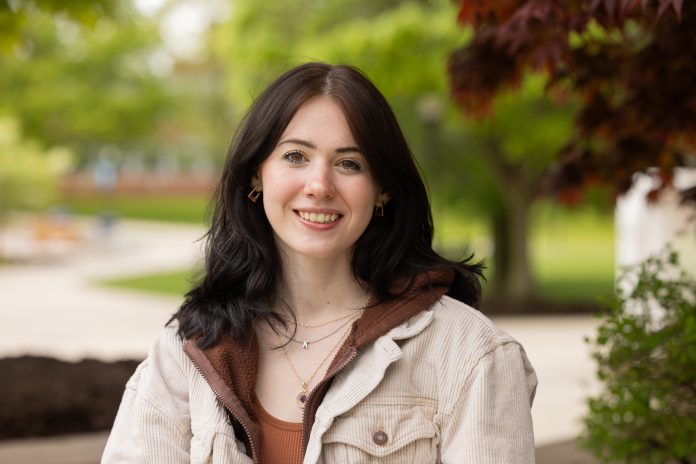Embarking on a journey of archaeological exploration often begins with a spark of curiosity and a mentor’s guiding hand. Thankfully, Charmaine Robichaud, ’24, found a way to travel to Ethiopia to the National Museum for an extensive field study opportunity comparing the animal remains of a 60,000-year-old site to a 13,000-year-old site from the Gona Project.
According to Robichaud, the Gona paleoanthropological field project in Ethiopia’s Afar region is renowned for uncovering the earliest Oldowan stone tools and has produced important archaeological findings that date from 2.6 million years ago to the conclusion of the Late Pleistocene.
She tackled a comprehensive study of faunal remains for her honors thesis, which she successfully defended this past spring semester. Her research aimed to enhance our understanding of human evolution in terms of diet, technology, and environmental interaction during a critical period of human history.
With a deep interest and dedication in her archaeology courses, Anthropology Professor Michael Rogers felt confident that this opportunity would not be wasted.
“Charlie is one of the brightest, hardest-working, most dedicated students I have had the privilege of teaching and mentoring,” said Rogers. “It is rare for an undergraduate student to be allowed access to these collections at the National Museum of Ethiopia, let alone to be given the first opportunity to analyze an assemblage. Usually, this work is done by graduate students or professionals.”
Below is an interview with Robichaud, reflecting on her research and travels before she graduates on Friday, May 17, with a B.S. in anthropology with a concentration in archeology.
How did you come to do research in Ethiopia?
In my junior year, Dr. Michael Rogers approached me with the idea of doing a field school in Ethiopia, as he is a main component of the Gona Project. Although we couldn’t go to the field itself, he saw my interest in zooarchaeology and pushed me to pursue that path. We discussed how I could use collections from the National Museum of Ethiopia to formulate an honors thesis. The trip finally came to be this January!
How extensive were the collections in the National Museum?
Being able to see the comparative collections room, the artifact storage basement, and the open exhibits was nothing like I’d ever seen before. I remember walking into the artifact storage room in the basement and my jaw dropped to the floor.
There were rows and rows of cabinets full of artifacts and then I looked over and saw several elephant and crocodile skulls overflowing on carts. It was amazing. But this museum is special because it has artifacts dating from 3 mya to the last 10,000 years. It was truly special.







What insights did you gain into prehistory while you were there?
Our ancestors were brilliant and much more in tune with their surroundings than what we give them credit for. I always mention this when there is a question of how people could have possibly done something 10kya, 30kya, or a million years ago: our ancestors had time to perfect their craft and their survival often depended on it.
We are at such a disconnect with the natural world nowadays but with our ancestors, the natural world is all they have ever known. They took advantage of their environment and cultivated technologies I still can’t wrap my head around.
What was it like to live and work in Ethiopia?
A culture shock was an understatement but I welcomed everything with open arms. There were so many things I took for granted back at home that I had to face on my trip. Like running water, a hot shower and paved sidewalks. But I truly fell in love with Addis and Ethiopian culture. We quickly had a routine, wake up at 7 a.m., get a coffee by 8, grab some scrambled eggs and tea at a cafe then walk to the museum.
Work from 9-5 then walk back and relax before heading to dinner. It was relatively simple, but everyone was so kind that they were invited to dinner at Dr. Sileshi’s (Dr. Rogers’ Gona Project counterpart) home on a few occasions. We were around for Timket and St Michael’s Day so I got to experience the religious holidays there as well!
What drew you to archaeology as a field of interest?
I’ve always been interested in human evolution as well as paleontology. My sophomore year I took ANT 205 and instantly fell in love with archaeology. It’s what I was missing! I was originally a biology major with a pre-vet intent but it didn’t take much convincing to switch over to anthropology and archaeology. It was the best decision I could have made for myself.
How supportive has your department at Southern been in helping you to achieve your goals?
I cannot speak highly enough of how supportive the anthropology faculty has been. Every anthropology professor I’ve had has been wonderful. Each and every one of them has been so encouraging in my endeavors and it is a pleasure knowing that I have such amazing people in my corner. They truly are some of the best people I know.
What do you hope to do post-grad?
I plan to work for a Cultural Resource Management (CRM) firm right after grad before moving to graduate school. Ideally, I’d go to Rice University in Houston to get my PhD in paleoanthropology so I can continue to have opportunities to work in Africa. That being said, I’ll go where the bones take me! So there’s some fluidity to my plan but I’m so excited to see where my future leads post-grad.


